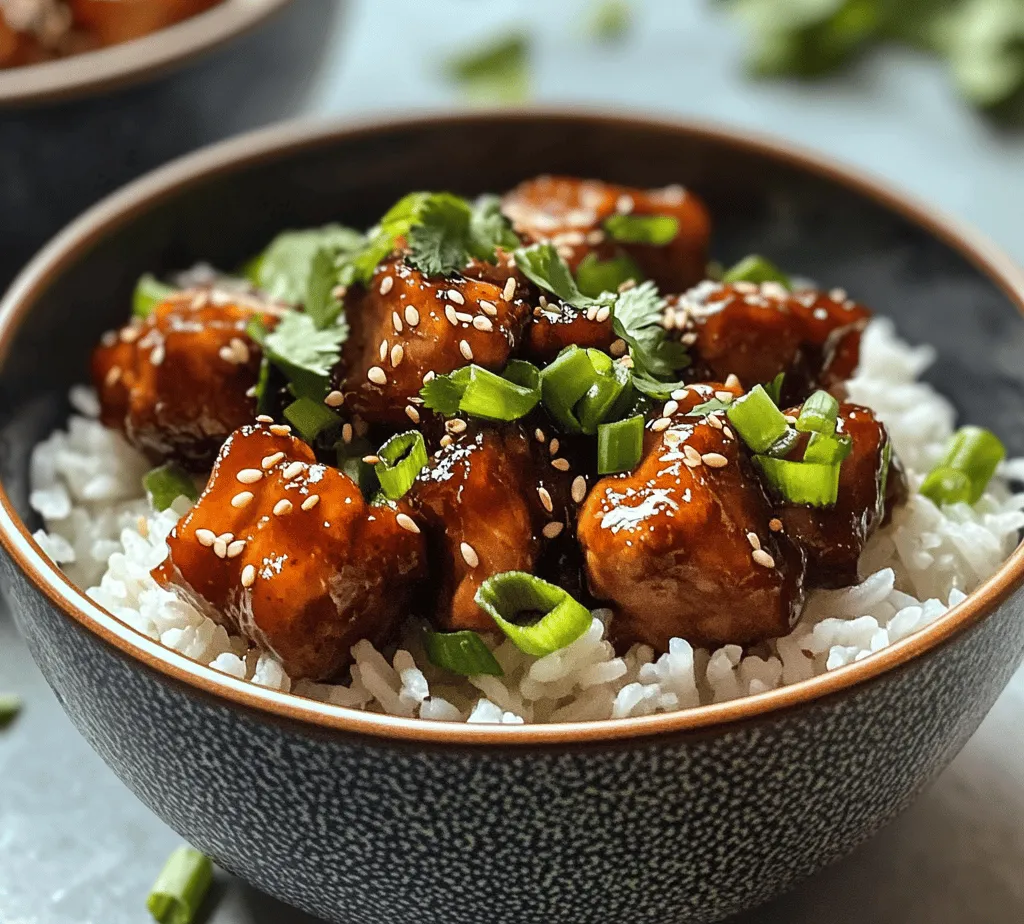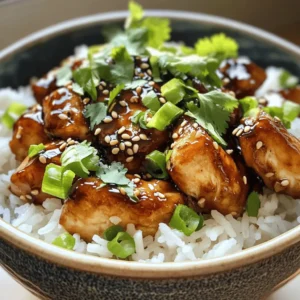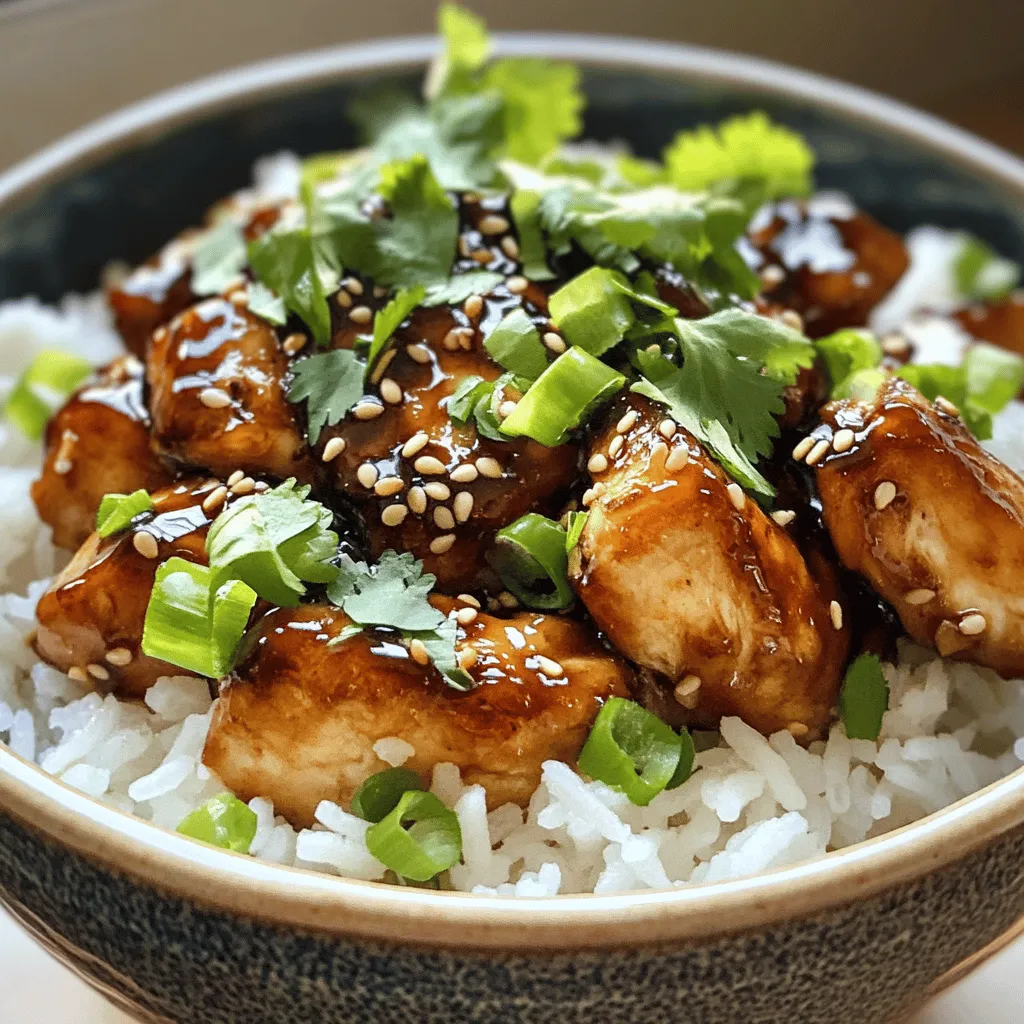Introduction
Rice bowls have become a beloved staple in kitchens around the world, celebrated for their versatility and comfort. They serve as a perfect canvas for a variety of ingredients, allowing you to mix and match according to your tastes and dietary preferences. From vibrant vegetable stir-fries to hearty protein options, rice bowls can cater to any meal of the day. Among the myriad of rice bowl options, sticky chicken rice bowls stand out as an exceptionally comforting and flavorful dish that brings warmth and satisfaction to the table.
Sticky chicken rice bowls are not just a meal; they embody a delightful balance of sweet and savory flavors that dance on your palate. This recipe features tender, marinated chicken thighs, perfectly cooked jasmine rice, and a medley of fresh ingredients that elevate the dish to new heights. Whether you’re preparing a weeknight dinner for the family or meal prepping for a busy week ahead, these rice bowls offer an amazing blend of flavors and textures that are sure to please everyone.
As you embark on this culinary journey, you’ll discover how the use of fresh ingredients and simple techniques can transform everyday cooking into an extraordinary experience. With a focus on balance, flavor, and ease, sticky chicken rice bowls are a dish that you will want to make time and time again.
Understanding the Ingredients
Jasmine Rice
At the heart of any great rice bowl is the rice itself, and for sticky chicken rice bowls, jasmine rice is the ideal choice. This long-grain variety of rice is known for its fragrant aroma and slightly sticky texture when cooked, which makes it a staple in many Asian cuisines. The delicate flavor of jasmine rice complements the robust flavors of the sticky chicken, creating a harmonious base for the dish.
When cooking with jasmine rice, it’s important to rinse it thoroughly before cooking. This removes excess starch that can lead to overly sticky rice, ensuring that each grain remains separate and fluffy. Additionally, jasmine rice is versatile; it can be paired with a multitude of flavors, enhancing the overall dining experience.
Boneless Chicken Thighs
For the protein component of our sticky chicken rice bowls, boneless chicken thighs are the star of the show. Unlike chicken breasts, thighs have a higher fat content, which results in juicier and more flavorful meat. This characteristic makes them particularly well-suited for marinating and cooking, as they remain tender and succulent even after being cooked at high temperatures.
Using boneless chicken thighs also simplifies the cooking process, allowing for quick preparation and easy handling. They are forgiving cuts of meat that absorb marinades beautifully, making them a perfect choice for this recipe. You can enjoy the rich, savory flavors of the chicken without the worry of it drying out during cooking—ensuring a delightful bite every time.
Key Flavor Agents
The magic of sticky chicken rice bowls lies in the harmony of flavors created by several key ingredients. The marinade is a blend of soy sauce, honey, rice vinegar, and sesame oil, each playing a crucial role in developing the dish’s signature taste.
– Soy Sauce: This umami-rich ingredient acts as the backbone of the marinade, providing depth and saltiness to the dish. It infuses the chicken with flavor, ensuring that each bite is savory and satisfying.
– Honey: The sweetness of honey balances the saltiness of the soy sauce, creating that perfect sweet-savory contrast that makes sticky chicken so appealing. It also aids in caramelization during cooking, giving the chicken a beautiful glaze.
– Rice Vinegar: This ingredient adds a touch of acidity, which brightens up the overall flavor profile and cuts through the richness of the chicken. It enhances the freshness of the dish, making each bite more enjoyable.
– Sesame Oil: A little goes a long way with sesame oil, which brings a nutty aroma and flavor to the marinade. It adds complexity and richness, rounding out the overall taste of the sticky chicken.
In addition to these main ingredients, garlic and ginger are essential components that elevate the flavor profile even further. Their aromatic qualities not only enhance the taste but also add a comforting warmth that is characteristic of many Asian dishes.
The Role of Cornstarch
To achieve that coveted sticky texture of the chicken glaze, cornstarch plays an important role as a thickening agent. When combined with the marinade, it helps create a luscious sauce that clings to the chicken, ensuring that you get a burst of flavor in every bite. Cornstarch is particularly useful because it thickens the sauce without altering the taste, allowing the original flavors of the marinade to shine through.
Preparation of the Rice
Rinsing Jasmine Rice
Now that we have a good understanding of the ingredients, it’s time to prepare the jasmine rice that will serve as the foundation of our sticky chicken rice bowls. The first step to achieving the perfect rice texture is rinsing the grains. Place the jasmine rice in a fine-mesh strainer or a bowl, and rinse it under cold running water. Swirl the rice around gently to remove excess starch, which can create a gummy texture when cooked. Rinse until the water runs clear; this ensures that the rice will cook up fluffy and separate.
Flavoring the Rice
For added depth of flavor, you can cook the rinsed jasmine rice in water or chicken broth. While water is the traditional choice, using chicken broth will infuse the rice with savory notes that complement the sticky chicken beautifully. Use a 1:1.5 ratio of rice to liquid (1 cup of rice to 1.5 cups of broth or water) for optimal cooking results.
Cooking Technique
To cook the rice, combine the rinsed jasmine rice and the chosen liquid in a medium saucepan. Bring the mixture to a boil over high heat. Once boiling, reduce the heat to low, cover the pan with a lid, and let it simmer for approximately 15-20 minutes. Avoid lifting the lid during cooking, as this allows steam to escape and can affect the cooking process.
After the cooking time is complete, remove the saucepan from the heat and let it sit, still covered, for an additional 10 minutes. This resting period allows the rice to finish cooking and helps develop a fluffy texture. After resting, fluff the rice with a fork to separate the grains before serving it as the base of your sticky chicken rice bowls.
Marinating the Chicken
The Importance of Marination
While the rice is cooking, it’s time to focus on marinating the chicken thighs. Marination is a crucial step in developing deep flavors that permeate the meat. The longer the chicken sits in the marinade, the more flavorful it becomes, which is why planning ahead can significantly enhance your dish.
Marinade Ingredients Breakdown
To create the marinade, combine soy sauce, honey, rice vinegar, sesame oil, minced garlic, and grated ginger in a bowl. The soy sauce provides umami, while honey adds sweetness; rice vinegar brightens the flavors, and sesame oil lends nuttiness. Garlic and ginger enhance the overall profile, contributing aromatic notes that make the chicken irresistible.
For the best results, allow the chicken thighs to marinate for at least 30 minutes. If time permits, marinating for 2-4 hours or even overnight in the refrigerator will yield even better flavor infusion. When you’re ready to cook, remove the chicken from the marinade, allowing any excess to drip off. This step is crucial for achieving that perfect caramelization during cooking.
Maximizing Flavor
Here are a few tips for maximizing flavor during the marination process:
– Use a Sealable Bag: Placing the chicken and marinade in a sealable plastic bag allows for more even coating and ensures that every piece of chicken absorbs the flavors.
– Massage the Marinade: After sealing the bag, give it a gentle massage to ensure the marinade coats the chicken evenly. This helps the flavors penetrate the meat more effectively.
– Bring to Room Temperature: Before cooking, let the marinated chicken sit at room temperature for about 15-20 minutes. This allows for more even cooking.
Cooking the Chicken
Techniques for Caramelization
Once the chicken is marinated and the rice is prepared, it’s time to cook the chicken to perfection. Start by heating a large skillet or frying pan over medium-high heat. Add a drizzle of oil to the pan, allowing it to heat up until shimmering.
When adding the chicken thighs to the pan, ensure that they’re spaced out and not overcrowded. Overcrowding can lead to steaming rather than searing, which inhibits the desired caramelization. Cook the chicken for about 5-7 minutes on each side, or until they are golden brown and cooked through. The key to achieving that beautiful caramelized exterior is to resist the urge to move the chicken around too much while it cooks. Allow each piece to develop a nice crust before flipping.
Once cooked, remove the chicken from the skillet and let it rest for a few minutes before slicing. This resting period allows the juices to redistribute, ensuring that each bite remains moist and flavorful.
As you prepare to assemble your sticky chicken rice bowls, the combination of perfectly cooked jasmine rice and succulent, caramelized chicken awaits, ready to be topped with fresh vegetables and garnishes for a delightful meal that is as visually appealing as it is delicious.

Discussion on the Right Heat Level and Timing for Perfect Doneness
Achieving the perfect doneness for your sticky chicken is crucial for both flavor and texture. The key lies in controlling the heat level during cooking. Start by heating your skillet over medium-high heat. This temperature is ideal for searing the chicken, allowing it to develop a golden-brown crust that locks in moisture. Once the chicken pieces are added to the pan, refrain from moving them around too much; let them sear for about 5-7 minutes on one side before flipping.
After the initial sear, reduce the heat to medium-low to allow the chicken to cook through without burning the marinade. This gentle cooking method ensures that the chicken remains juicy and tender while absorbing the rich flavors of the marinade. Use a meat thermometer to check for doneness, aiming for an internal temperature of 165°F (74°C). This step is not only vital for food safety but also for achieving that perfect bite.
Thickening the Sauce
Thickening the sauce is an essential step that can elevate your sticky chicken rice bowls from good to great. A sauce that clings to the chicken and rice creates a harmonious dish that’s both visually appealing and satisfying.
Explanation of How Cornstarch Works as a Thickening Agent
Cornstarch is a common thickening agent used in many sauces due to its neutral flavor and ability to create a glossy finish. When mixed with cold water and heated, cornstarch granules swell and absorb liquid, thickening the sauce as it simmers. This thickening capability allows you to control the consistency of your sauce, making it perfect for coating your chicken and rice.
Step-by-Step Process for Integrating the Cornstarch Mixture into the Dish
1. Prepare the Cornstarch Slurry: In a small bowl, combine 1 tablespoon of cornstarch with 2 tablespoons of cold water. Stir until smooth. This mixture is known as a slurry and will help thicken the sauce without creating lumps.
2. Add to the Sauce: Once your chicken is cooked and the marinade has reduced slightly, lower the heat to a simmer. Gradually add the cornstarch slurry to the pan while stirring continuously. This will help prevent lumps from forming.
3. Cook Until Thickened: Continue to cook the sauce for an additional 2-3 minutes. You’ll notice the sauce becoming thicker and more cohesive, which is ideal for coating your chicken.
4. Evaluate the Consistency: If you prefer a thicker sauce, you can prepare another batch of slurry and repeat the process. Conversely, if the sauce becomes too thick, simply add a splash of chicken broth or water to achieve your desired consistency.
Visually, a thin sauce will run off the chicken, while a thickened sauce will cling beautifully, creating a luscious coating that enhances each bite.
Assembling the Sticky Chicken Rice Bowls
Now that your chicken is cooked and coated in a rich, thick sauce, it’s time to assemble your sticky chicken rice bowls. Presentation can significantly enhance the dining experience, so take a moment to consider how to layer your ingredients.
Creative Tips for Layering the Rice and Chicken for Visual Appeal
1. Start with the Rice: Use a generous scoop of fluffy, cooked rice as the base of your bowl. This will absorb any extra sauce, adding flavor and moisture.
2. Add the Chicken: Place the sticky chicken pieces on top of the rice, ensuring they are evenly distributed. This not only helps with flavor but also creates an appealing height.
3. Drizzle with Sauce: Spoon extra sauce over the chicken, allowing it to cascade down onto the rice. This adds a glossy finish and enhances the overall presentation.
4. Incorporate Textural Elements: Consider adding slices of cucumbers or pickled vegetables for a refreshing crunch. This contrast in texture will elevate the dish even further.
Suggestions for Garnishing with Green Onions, Sesame Seeds, and Cilantro
Garnishing is where you can truly add your personal touch. Finely chop green onions and sprinkle them over the top for a burst of color and flavor. Toasted sesame seeds can also be sprinkled for an added nutty flavor and crunch. Finally, a scattering of fresh cilantro not only provides a pop of green but also brightens up the flavors.
Importance of Presentation in Enhancing the Overall Dining Experience
Don’t underestimate the power of presentation. A well-assembled bowl not only looks appetizing but also enhances the anticipation of enjoying your meal. Take the time to arrange your ingredients thoughtfully; your efforts will be rewarded as you and your guests savor each delightful bite.
Serving Suggestions
Sticky chicken rice bowls are versatile and can be paired with a variety of sides and drinks to create a complete meal.
Ideas for Pairing Sticky Chicken Rice Bowls with Side Dishes or Drinks
1. Side Dishes: Consider serving your rice bowls with a side of steamed vegetables, such as broccoli or bok choy. A fresh salad with a light vinaigrette can also complement the richness of the chicken.
2. Drinks: Pair your dish with a refreshing iced tea, a light beer, or even a fruity cocktail to balance the flavors.
Discussion on Variations of the Dish
While the classic sticky chicken rice bowl is undeniably delicious, don’t hesitate to experiment with variations. You can add sautéed bell peppers, snap peas, or carrots for additional vegetables. For a different protein, try using shrimp, tofu, or even grilled beef. Each variation can bring a new depth of flavor and texture to the dish.
Suggestions for Dietary Adjustments
If you’re looking to make dietary adjustments, there are plenty of options. For a vegetarian alternative, substitute the chicken with marinated tofu or tempeh. You can also use brown rice or cauliflower rice for a healthier carb option. These modifications not only cater to dietary preferences but also allow you to enjoy the dish in various ways.
Nutritional Information
Understanding the nutritional content of your dish can help you make informed choices when preparing meals.
Breakdown of Caloric Content and Nutritional Benefits of the Main Ingredients
A typical serving of sticky chicken rice bowls contains approximately 500-600 calories, depending on the portion sizes and specific ingredients used. The main components—chicken, rice, and vegetables—offer a balance of protein, carbohydrates, and vitamins.
– Chicken: A great source of lean protein, which is essential for muscle building and repair.
– Rice: Provides carbohydrates for energy, and using brown rice can add additional fiber.
– Vegetables: Contribute vitamins, minerals, and antioxidants, enhancing the overall nutritional profile of the dish.
Discussion on the Health Benefits of Using Fresh Ingredients Versus Processed Options
Opting for fresh ingredients over processed options not only improves the taste of your dish but also boosts its nutritional value. Fresh vegetables are packed with nutrients and offer more flavor than their canned counterparts. Similarly, using fresh chicken rather than pre-marinated varieties can reduce sodium levels and allow you to control the flavor profile of your dish.
Offering Insights into Balancing Meals with Protein, Carbs, and Vegetables
When preparing your sticky chicken rice bowls, aim for a balance of protein, carbohydrates, and vegetables. This combination will help you feel satisfied and provide sustained energy. Including a variety of colorful vegetables not only enhances the visual appeal but also ensures you’re getting a range of nutrients.
Conclusion
In conclusion, sticky chicken rice bowls are a delightful and easy-to-make dish that brings together savory flavors, satisfying textures, and nutritional benefits. Whether you’re preparing a weeknight dinner or hosting friends, this recipe allows for culinary creativity and personalization.
Cooking is not just about following a recipe; it’s about the joy of experimenting, sharing meals with loved ones, and creating lasting memories. As you explore variations of this dish, embrace the opportunity to make it your own, celebrating the flavors and inspirations that resonate with you. So gather your ingredients, ignite your passion for cooking, and enjoy the satisfaction of a comforting, homemade meal.



